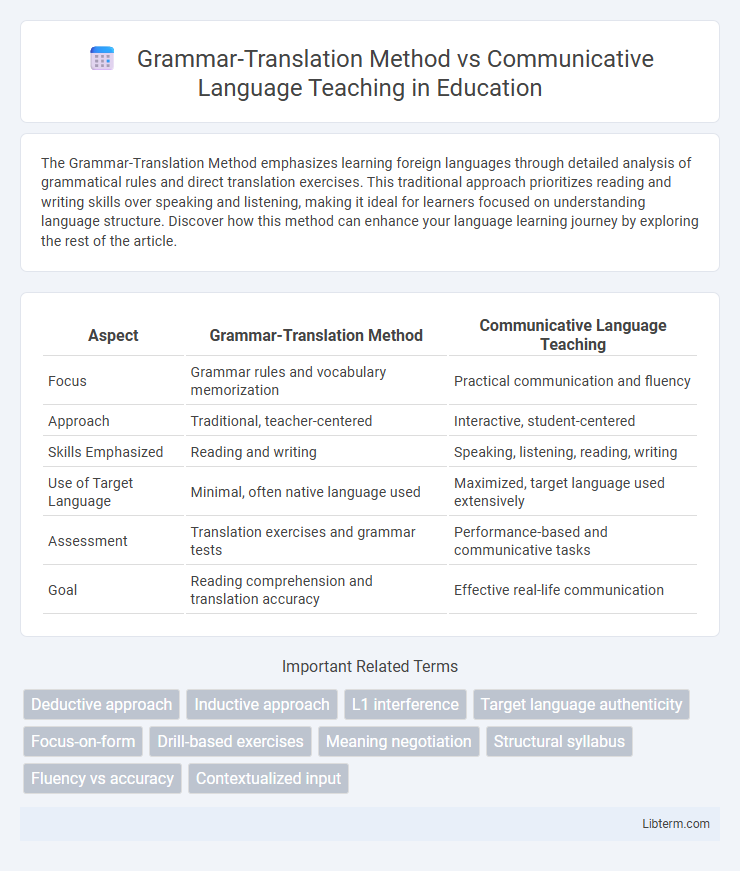The Grammar-Translation Method emphasizes learning foreign languages through detailed analysis of grammatical rules and direct translation exercises. This traditional approach prioritizes reading and writing skills over speaking and listening, making it ideal for learners focused on understanding language structure. Discover how this method can enhance your language learning journey by exploring the rest of the article.
Table of Comparison
| Aspect | Grammar-Translation Method | Communicative Language Teaching |
|---|---|---|
| Focus | Grammar rules and vocabulary memorization | Practical communication and fluency |
| Approach | Traditional, teacher-centered | Interactive, student-centered |
| Skills Emphasized | Reading and writing | Speaking, listening, reading, writing |
| Use of Target Language | Minimal, often native language used | Maximized, target language used extensively |
| Assessment | Translation exercises and grammar tests | Performance-based and communicative tasks |
| Goal | Reading comprehension and translation accuracy | Effective real-life communication |
Introduction to Language Teaching Methods
Grammar-Translation Method emphasizes explicit grammar instruction and translation exercises to develop reading and writing skills, often prioritizing accuracy over fluency. Communicative Language Teaching focuses on interaction and practical communication, encouraging students to use language in real-life contexts to enhance speaking and listening proficiency. Both methods represent foundational approaches in the introduction to language teaching methods, highlighting different priorities in language acquisition.
Overview of the Grammar-Translation Method
The Grammar-Translation Method emphasizes the explicit teaching of grammatical rules and vocabulary through direct translation between the target language and the native language. This traditional approach prioritizes reading and writing skills over speaking and listening, often using classical texts to reinforce language structure. Its main goal is to develop the learner's ability to comprehend and translate complex sentences rather than engage in spontaneous communication.
Key Principles of Grammar-Translation Method
The Grammar-Translation Method emphasizes explicit instruction of grammatical rules and vocabulary through detailed analysis of written texts, focusing heavily on reading and writing over speaking skills. It relies on direct translation between the target language and the native language to understand language structures and reinforce memorization. Error correction in this method is strict and accuracy in grammar is prioritized above communicative competence.
Overview of Communicative Language Teaching
Communicative Language Teaching (CLT) emphasizes interaction and real-life communication skills over rote memorization and explicit grammar instruction found in the Grammar-Translation Method. CLT promotes student-centered learning through activities like role-plays, discussions, and problem-solving tasks to foster practical language use. This method prioritizes fluency and meaning, integrating listening, speaking, reading, and writing skills in authentic contexts.
Core Features of Communicative Language Teaching
Communicative Language Teaching (CLT) emphasizes real-life communication and interaction as the primary goal of language learning, focusing on functional language use rather than rote memorization of grammar rules typical of the Grammar-Translation Method. Core features of CLT include task-based learning, learner-centered activities, and the development of all four language skills--speaking, listening, reading, and writing--in authentic contexts. This method encourages fluency and meaningful communication, promoting negotiation of meaning and cultural competence to enhance practical language proficiency.
Differences Between Grammar-Translation and CLT
The Grammar-Translation Method emphasizes the explicit teaching of grammatical rules and vocabulary through written exercises and translation between the target language and the native language. In contrast, Communicative Language Teaching (CLT) prioritizes interactive speaking and listening skills, focusing on real-life communication and fluency rather than accuracy alone. While Grammar-Translation relies heavily on reading and writing, CLT encourages spontaneous dialogue and practical language use in immersive, contextual settings.
Advantages of Grammar-Translation Method
The Grammar-Translation Method offers strong advantages in developing learners' reading and writing skills, particularly through its emphasis on vocabulary, grammar rules, and translation exercises. It provides a systematic approach that enhances learners' understanding of language structure and classical texts, making it especially useful for academic purposes and language preservation. This method also enables learners to build a solid foundation in their native language while acquiring the target language, facilitating cross-linguistic comparison and cognitive skills development.
Benefits of Communicative Language Teaching
Communicative Language Teaching (CLT) emphasizes interaction and real-life communication, improving learners' speaking and listening skills more effectively than the Grammar-Translation Method, which centers on grammar rules and translation exercises. CLT fosters greater learner engagement and motivation by encouraging meaningful dialogues and practical language use. This method also enhances cultural competence and fluency, preparing students for authentic communication in diverse contexts.
Challenges and Criticisms of Both Approaches
The Grammar-Translation Method faces criticism for its emphasis on rote memorization and lack of focus on practical communication skills, leading to limited speaking and listening proficiency among learners. Communicative Language Teaching, while prioritizing interaction and real-life communication, often encounters challenges in assessment due to its less structured syllabus and the difficulty of measuring communicative competence objectively. Both approaches struggle with balancing linguistic accuracy and fluency, and teachers must navigate these limitations to effectively address diverse learner needs.
Choosing the Right Method for Language Learners
Selecting the appropriate language teaching method depends on learners' goals and contexts; Grammar-Translation Method suits learners aiming for reading comprehension and translation skills, emphasizing grammar rules and vocabulary memorization. Communicative Language Teaching (CLT) prioritizes practical communication and fluency through interactive activities, making it ideal for learners seeking conversational competence and real-life language use. Matching the method to learners' needs, proficiency levels, and learning environments enhances language acquisition effectiveness and motivation.
Grammar-Translation Method Infographic

 libterm.com
libterm.com